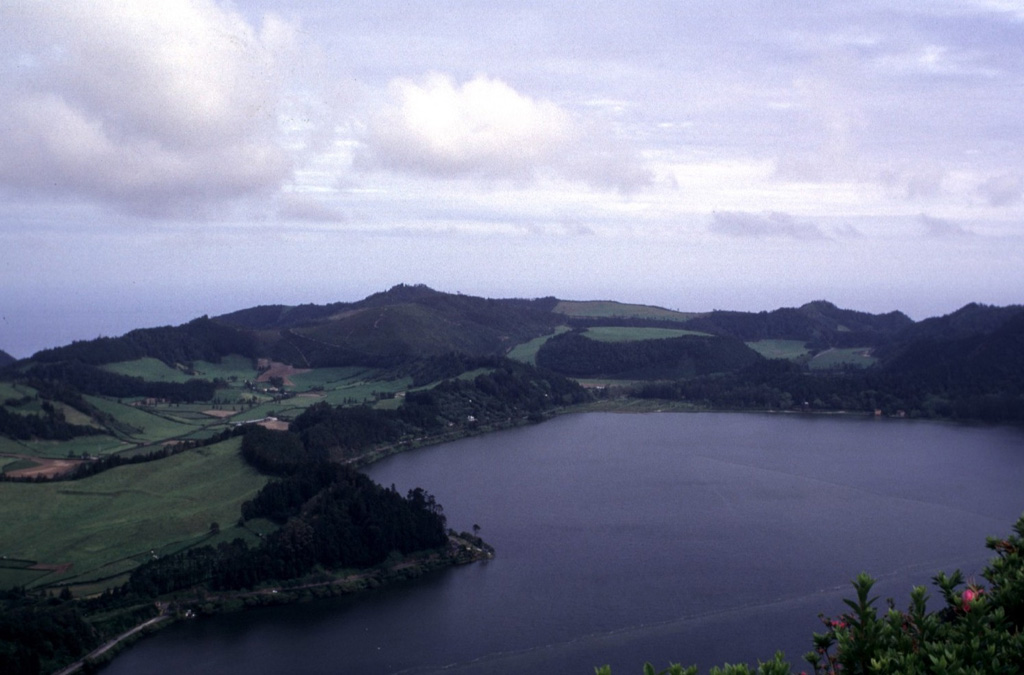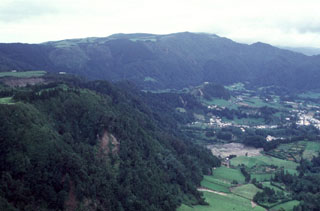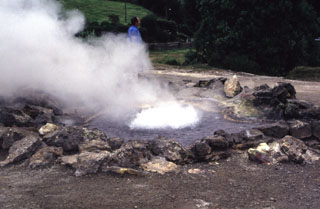

The Global Volcanism Program has no activity reports available for Furnas.
The Global Volcanism Program has no Weekly Reports available for Furnas.
The Global Volcanism Program has no Bulletin Reports available for Furnas.
This compilation of synonyms and subsidiary features may not be comprehensive. Features are organized into four major categories: Cones, Craters, Domes, and Thermal Features. Synonyms of features appear indented below the primary name. In some cases additional feature type, elevation, or location details are provided.
Cones |
||||
| Feature Name | Feature Type | Elevation | Latitude | Longitude |
| Azeitona, Pico da | Cone | 537 m | ||
| Canario, Pico de | Pyroclastic cone | 615 m | 37° 46' 0" N | 25° 17' 0" W |
| Gafanhoto | Cone | 715 m | 37° 47' 0" N | 25° 19' 0" W |
| Nordeste | Shield volcano | 1105 m | 37° 47' 0" N | 25° 13' 0" W |
| Senhora, Pica da | Cone | 455 m | 37° 49' 0" N | 25° 20' 0" W |
Craters |
||||
| Feature Name | Feature Type | Elevation | Latitude | Longitude |
| Povoacao | Pleistocene caldera | 1105 m | 37° 46' 0" N | 25° 15' 0" W |
Domes |
||||
| Feature Name | Feature Type | Elevation | Latitude | Longitude |
|
Areia, Pico Da
Cova Da Burra |
Dome | 495 m | 37° 44' 0" N | 25° 19' 0" W |
| Buraco, Pico do | Dome | 702 m | ||
| Ferro, Pico do | Dome | 544 m | 37° 46' 0" N | 25° 20' 0" W |
| Gaspar, Pico Do | Dome | 382 m | 37° 45' 0" N | 25° 19' 0" W |
|
Marcondas, Pica das
Murcondas, Pica das |
Dome | 398 m | 37° 46' 0" N | 25° 18' 0" W |
Thermal |
||||
| Feature Name | Feature Type | Elevation | Latitude | Longitude |
| Caldieras | Thermal | |||
| Ribiera Dos Tambores | Thermal | |||
|
|
||||||||||||||||||||||||||
There is data available for 9 confirmed Holocene eruptive periods.
1630 Sep 3 - 1630 Nov 2 Confirmed Eruption VEI: 5
| Episode 1 | Eruption | South end of caldera (Pico da Areia) | |||||||||||||||||||||||||||||||||||||||||||||||||||||||||||||||||||||||||||||||
|---|---|---|---|---|---|---|---|---|---|---|---|---|---|---|---|---|---|---|---|---|---|---|---|---|---|---|---|---|---|---|---|---|---|---|---|---|---|---|---|---|---|---|---|---|---|---|---|---|---|---|---|---|---|---|---|---|---|---|---|---|---|---|---|---|---|---|---|---|---|---|---|---|---|---|---|---|---|---|---|---|
| 1630 Sep 3 - 1630 Nov 2 | Evidence from Observations: Reported | |||||||||||||||||||||||||||||||||||||||||||||||||||||||||||||||||||||||||||||||
|
List of 14 Events for Episode 1 at South end of caldera (Pico da Areia)
| ||||||||||||||||||||||||||||||||||||||||||||||||||||||||||||||||||||||||||||||||
1441 ± 2 years Confirmed Eruption VEI: 4
| Episode 1 | Eruption | Center of caldera (Gaspar), Tephra layer I | |||||||||||||||||||||||||||||||||||||||
|---|---|---|---|---|---|---|---|---|---|---|---|---|---|---|---|---|---|---|---|---|---|---|---|---|---|---|---|---|---|---|---|---|---|---|---|---|---|---|---|---|
| 1441 ± 2 years - Unknown | Evidence from Observations: Reported | |||||||||||||||||||||||||||||||||||||||
|
List of 6 Events for Episode 1 at Center of caldera (Gaspar), Tephra layer I
| ||||||||||||||||||||||||||||||||||||||||
1430 ± 100 years Confirmed Eruption VEI: 3
| Episode 1 | Eruption | East caldera floor, Tephra layer H | ||||||||||||||||||||||||||||||||||
|---|---|---|---|---|---|---|---|---|---|---|---|---|---|---|---|---|---|---|---|---|---|---|---|---|---|---|---|---|---|---|---|---|---|---|---|
| 1430 ± 100 years - Unknown | Evidence from Isotopic: 14C (uncalibrated) | ||||||||||||||||||||||||||||||||||
|
List of 5 Events for Episode 1 at East caldera floor, Tephra layer H
| |||||||||||||||||||||||||||||||||||
1170 ± 100 years Confirmed Eruption VEI: 4
| Episode 1 | Eruption | E caldera floor (Lake crater), Tephra layer G | |||||||||||||||||||||||||||||
|---|---|---|---|---|---|---|---|---|---|---|---|---|---|---|---|---|---|---|---|---|---|---|---|---|---|---|---|---|---|---|
| 1170 ± 100 years - Unknown | Evidence from Isotopic: 14C (uncalibrated) | |||||||||||||||||||||||||||||
|
List of 4 Events for Episode 1 at E caldera floor (Lake crater), Tephra layer G
| ||||||||||||||||||||||||||||||
0840 ± 100 years Confirmed Eruption VEI: 4
| Episode 1 | Eruption | Center of caldera (Gaspar), Tephra layer F | |||||||||||||||||||||||||||||
|---|---|---|---|---|---|---|---|---|---|---|---|---|---|---|---|---|---|---|---|---|---|---|---|---|---|---|---|---|---|---|
| 0840 ± 100 years - Unknown | Evidence from Isotopic: 14C (uncalibrated) | |||||||||||||||||||||||||||||
|
List of 4 Events for Episode 1 at Center of caldera (Gaspar), Tephra layer F
| ||||||||||||||||||||||||||||||
0080 ± 100 years Confirmed Eruption VEI: 5
| Episode 1 | Eruption | N floor of younger caldera, Tephra layer C | |||||||||||||||||||||||||||||||||||||||
|---|---|---|---|---|---|---|---|---|---|---|---|---|---|---|---|---|---|---|---|---|---|---|---|---|---|---|---|---|---|---|---|---|---|---|---|---|---|---|---|---|
| 0080 ± 100 years - Unknown | Evidence from Isotopic: 14C (uncalibrated) | |||||||||||||||||||||||||||||||||||||||
|
List of 6 Events for Episode 1 at N floor of younger caldera, Tephra layer C
| ||||||||||||||||||||||||||||||||||||||||
0360 BCE ± 150 years Confirmed Eruption
| Episode 1 | Eruption | Tephra layer B | ||||||||||||||||||||||||
|---|---|---|---|---|---|---|---|---|---|---|---|---|---|---|---|---|---|---|---|---|---|---|---|---|---|
| 0360 BCE ± 150 years - Unknown | Evidence from Isotopic: 14C (uncalibrated) | ||||||||||||||||||||||||
|
List of 3 Events for Episode 1 at Tephra layer B
| |||||||||||||||||||||||||
1670 BCE ± 1460 years Confirmed Eruption
| Episode 1 | Eruption | Tephra layer A | ||||||||||||||||||||||||
|---|---|---|---|---|---|---|---|---|---|---|---|---|---|---|---|---|---|---|---|---|---|---|---|---|---|
| 1670 BCE ± 1460 years - Unknown | Evidence from Correlation: Tephrochronology | ||||||||||||||||||||||||
|
List of 3 Events for Episode 1 at Tephra layer A
| |||||||||||||||||||||||||
4570 BCE (in or before) Confirmed Eruption
| Episode 1 | Eruption | East rim of caldera (Pico do Canário) | |||||||||||||||||||
|---|---|---|---|---|---|---|---|---|---|---|---|---|---|---|---|---|---|---|---|---|
| 4570 BCE (in or before) - Unknown | Evidence from Isotopic: 14C (uncalibrated) | |||||||||||||||||||
|
List of 2 Events for Episode 1 at East rim of caldera (Pico do Canário)
| ||||||||||||||||||||
There is no Deformation History data available for Furnas.
There is no Emissions History data available for Furnas.
 The village of Furnas (right) lies in the center of Furnas caldera, whose northern rim forms the ridge in the background. The largest eruption in the last 5,000 years originated at a vent where the village is now located. This Plinian eruption, named Furnas C, occurred about 1,900 years ago. Activity varied between phreatomagmatic and magmatic styles, producing massive fallout of pumice and ash and pyroclastic flows and surges.
The village of Furnas (right) lies in the center of Furnas caldera, whose northern rim forms the ridge in the background. The largest eruption in the last 5,000 years originated at a vent where the village is now located. This Plinian eruption, named Furnas C, occurred about 1,900 years ago. Activity varied between phreatomagmatic and magmatic styles, producing massive fallout of pumice and ash and pyroclastic flows and surges. The low hill covered by fields (left center) is Pico do Gaspar lava dome, surrounded by a low tuff cone. The Lagoa das Furnas lies to the west (right) and the eastern caldera wall can be seen in the left background. The Pico do Gaspar dome has been the site of two eruptions, including in about 1439-1443 CE; descriptions suggest an initial explosive phase producing ash, followed by lava dome formation.
The low hill covered by fields (left center) is Pico do Gaspar lava dome, surrounded by a low tuff cone. The Lagoa das Furnas lies to the west (right) and the eastern caldera wall can be seen in the left background. The Pico do Gaspar dome has been the site of two eruptions, including in about 1439-1443 CE; descriptions suggest an initial explosive phase producing ash, followed by lava dome formation.  Hydrothermal features at Furnas include several fields of fumaroles, hot springs, bubbling pools and mudpits, and the emission of carbon dioxide both at springs and through the soil. Fumarole fields are found on the north shore of Furnas Lake, in the river gorge of the Ribeira Quente, the Ribeira Quente village on the coast outside of the caldera, and in the upper Ribeira dos Tambores. A significant fumarole field, including the hot spring seen here, is located in the main fumarole field, Caldeiras das Furnas, in the village of Furnas.
Hydrothermal features at Furnas include several fields of fumaroles, hot springs, bubbling pools and mudpits, and the emission of carbon dioxide both at springs and through the soil. Fumarole fields are found on the north shore of Furnas Lake, in the river gorge of the Ribeira Quente, the Ribeira Quente village on the coast outside of the caldera, and in the upper Ribeira dos Tambores. A significant fumarole field, including the hot spring seen here, is located in the main fumarole field, Caldeiras das Furnas, in the village of Furnas. Furnas volcano, at the eastern end of Sao Miguel Island, contains two nested calderas. The southern rim of the younger 6-km-wide caldera is seen here from the north, with Furnas Lake on the right foreground. At least 10 trachytic pumice layers, all erupted during the past 5,000 years, post-date the caldera. The dome with the semi-circle of trees in the center behind the lake is the site of the most recent eruption at Furnas, a sub-Plinian eruption in 1630 CE.
Furnas volcano, at the eastern end of Sao Miguel Island, contains two nested calderas. The southern rim of the younger 6-km-wide caldera is seen here from the north, with Furnas Lake on the right foreground. At least 10 trachytic pumice layers, all erupted during the past 5,000 years, post-date the caldera. The dome with the semi-circle of trees in the center behind the lake is the site of the most recent eruption at Furnas, a sub-Plinian eruption in 1630 CE.Maps are not currently available due to technical issues.
There are no samples for Furnas in the Smithsonian's NMNH Department of Mineral Sciences Rock and Ore collection.
| Copernicus Browser | The Copernicus Browser replaced the Sentinel Hub Playground browser in 2023, to provide access to Earth observation archives from the Copernicus Data Space Ecosystem, the main distribution platform for data from the EU Copernicus missions. |
| MIROVA | Middle InfraRed Observation of Volcanic Activity (MIROVA) is a near real time volcanic hot-spot detection system based on the analysis of MODIS (Moderate Resolution Imaging Spectroradiometer) data. In particular, MIROVA uses the Middle InfraRed Radiation (MIR), measured over target volcanoes, in order to detect, locate and measure the heat radiation sourced from volcanic activity. |
| MODVOLC Thermal Alerts | Using infrared satellite Moderate Resolution Imaging Spectroradiometer (MODIS) data, scientists at the Hawai'i Institute of Geophysics and Planetology, University of Hawai'i, developed an automated system called MODVOLC to map thermal hot-spots in near real time. For each MODIS image, the algorithm automatically scans each 1 km pixel within it to check for high-temperature hot-spots. When one is found the date, time, location, and intensity are recorded. MODIS looks at every square km of the Earth every 48 hours, once during the day and once during the night, and the presence of two MODIS sensors in space allows at least four hot-spot observations every two days. Each day updated global maps are compiled to display the locations of all hot spots detected in the previous 24 hours. There is a drop-down list with volcano names which allow users to 'zoom-in' and examine the distribution of hot-spots at a variety of spatial scales. |
|
WOVOdat
Single Volcano View Temporal Evolution of Unrest Side by Side Volcanoes |
WOVOdat is a database of volcanic unrest; instrumentally and visually recorded changes in seismicity, ground deformation, gas emission, and other parameters from their normal baselines. It is sponsored by the World Organization of Volcano Observatories (WOVO) and presently hosted at the Earth Observatory of Singapore.
GVMID Data on Volcano Monitoring Infrastructure The Global Volcano Monitoring Infrastructure Database GVMID, is aimed at documenting and improving capabilities of volcano monitoring from the ground and space. GVMID should provide a snapshot and baseline view of the techniques and instrumentation that are in place at various volcanoes, which can be use by volcano observatories as reference to setup new monitoring system or improving networks at a specific volcano. These data will allow identification of what monitoring gaps exist, which can be then targeted by remote sensing infrastructure and future instrument deployments. |
| Volcanic Hazard Maps | The IAVCEI Commission on Volcanic Hazards and Risk has a Volcanic Hazard Maps database designed to serve as a resource for hazard mappers (or other interested parties) to explore how common issues in hazard map development have been addressed at different volcanoes, in different countries, for different hazards, and for different intended audiences. In addition to the comprehensive, searchable Volcanic Hazard Maps Database, this website contains information about diversity of volcanic hazard maps, illustrated using examples from the database. This site is for educational purposes related to volcanic hazard maps. Hazard maps found on this website should not be used for emergency purposes. For the most recent, official hazard map for a particular volcano, please seek out the proper institutional authorities on the matter. |
| IRIS seismic stations/networks | Incorporated Research Institutions for Seismology (IRIS) Data Services map showing the location of seismic stations from all available networks (permanent or temporary) within a radius of 0.18° (about 20 km at mid-latitudes) from the given location of Furnas. Users can customize a variety of filters and options in the left panel. Note that if there are no stations are known the map will default to show the entire world with a "No data matched request" error notice. |
| UNAVCO GPS/GNSS stations | Geodetic Data Services map from UNAVCO showing the location of GPS/GNSS stations from all available networks (permanent or temporary) within a radius of 20 km from the given location of Furnas. Users can customize the data search based on station or network names, location, and time window. Requires Adobe Flash Player. |
| DECADE Data | The DECADE portal, still in the developmental stage, serves as an example of the proposed interoperability between The Smithsonian Institution's Global Volcanism Program, the Mapping Gas Emissions (MaGa) Database, and the EarthChem Geochemical Portal. The Deep Earth Carbon Degassing (DECADE) initiative seeks to use new and established technologies to determine accurate global fluxes of volcanic CO2 to the atmosphere, but installing CO2 monitoring networks on 20 of the world's 150 most actively degassing volcanoes. The group uses related laboratory-based studies (direct gas sampling and analysis, melt inclusions) to provide new data for direct degassing of deep earth carbon to the atmosphere. |
| Large Eruptions of Furnas | Information about large Quaternary eruptions (VEI >= 4) is cataloged in the Large Magnitude Explosive Volcanic Eruptions (LaMEVE) database of the Volcano Global Risk Identification and Analysis Project (VOGRIPA). |
| EarthChem | EarthChem develops and maintains databases, software, and services that support the preservation, discovery, access and analysis of geochemical data, and facilitate their integration with the broad array of other available earth science parameters. EarthChem is operated by a joint team of disciplinary scientists, data scientists, data managers and information technology developers who are part of the NSF-funded data facility Integrated Earth Data Applications (IEDA). IEDA is a collaborative effort of EarthChem and the Marine Geoscience Data System (MGDS). |